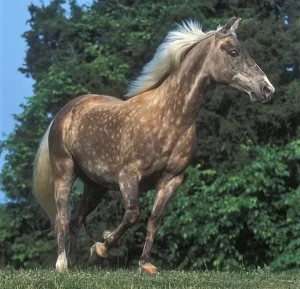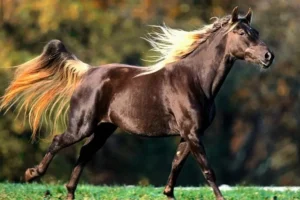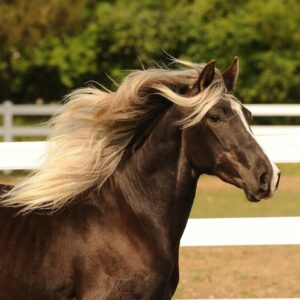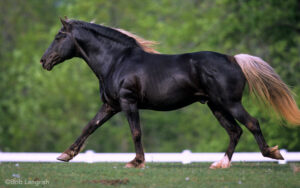6 Interesting Facts About Rocky Mountain Horses.

The Rocky Mountain Horse is a stunning breed in both appearance and temperament. Known for their comfortable gaits and affection for humans, these horses are sure to steal your heart! The history of the breed is similar to that of the Kentucky Mountain Saddle Horse, and both breeds are recognized by the Mountain Pleasure Horse Association.

There are two types of Rocky Mountain Horses: the foundation type and the modern type. These horses are of medium weight, with an average height of 14 to 16. The Rocky Mountain Horse has excellently adapted to its mountainous environment. Winters are not a problem for these robust horses, and neither are low temperatures.
1- The Breed Didn’t Originate in the Rocky Mountains
Despite its name, the Rocky Mountain Horse developed in the Appalachian Mountains of Kentucky. It was the foundation stallion that initially came from the Rocky Mountains of the western United States. Around 1890, this stallion, dubbed the “Rocky Mountain Horse,” came in eastern Kentucky as a colt. He already possessed important characteristics of the contemporary breed, such as a chocolate flaxen hue and natural gait. This stallion was used to breed local mares, and a new breed of horse arose as a result.

2- There Are Around 25,000 Rocky Mountain Horses in Existence
Rocky Mountain Horses were a popular means of transport due to their comfortable gaits and surefootedness. While the improving infrastructure eliminated the need for gaited horses throughout the United States, Rocky Mountain Horses were still needed in the less developed Appalachian Mountains. As a result, the breed has survived to the present day. The Rocky Mountain Horse Association was founded in 1986, despite the fact that the breed has been around since the late 1800s. The group had over 12,000 registered horses by 2005, and by 2015, it had grown to 25,000. Only the offspring of registered Rocky Mountain Horses may be considered purebred when the studbook is closed.
Kentucky is home to over half of the world’s Rocky Mountain Horse population, according to Horse Canada. The breed has grown in popularity to the point where it can currently be found in 47 states and 11 countries.

3- Most Rocky Mountain Horses Are Silver Dapple
Most, but not all, Rocky Mountain Horses boast a fabulous chocolate coat and flaxen mane and tail. Considered one of the rarest horse coat colors, this unique coloration results from the rare silver dapple gene expressed on a black base color. This gene produces the dappling effect on the horse’s coat and a mane and tail several shades lighter than the coat. While chocolate flaxen is the most common and popular color in the breed, the registry accepts all solid colors. Black is the second most common hue, with palominos accounting for about 2.5 percent of the population. Buckskin and cremello dilution hues, as well as the rare roan, can also be seen. White marks are only allowed on the legs and head, according to the register. Horses with white markings that reach above the knee cannot be registered.

4- Morgan Horses Are Gaited
Gaited horses exhibit special gaits other than walk, trot, canter, and gallop. Eastern Kentucky has long been known for its gaited horse breeds, which are descended from English and Spanish horses. It’s no different with the Rocky Mountain Horse. Rather from trotting, these horses walk in a four-beat ambling gait known as “single-foot.” This is an intermediate gait, similar to the trot, but there is no pause between the footfalls. The single-foot gait gives a significantly smoother riding experience than a two-beat gait since one foot is always on the ground. The single-foot gait is not only more pleasant for the rider, but it is also more efficient. On uneven ground, horses in this gait can maintain a speed of 7 mph (11 km/h) and up to 16 mph (26 km/h) on smooth ground. Trot, on the other hand, has an average pace of 6 to 8 mph (9.7 to 12.9 km/h).

5- They Make Excellent Trail Riding And Ranch Horses
Historically, the Rocky Mountain Horse served as an all-around riding, driving, and workhorse. Farmers used these horses to work the lands in the Appalachian foothills and herd cattle. Meanwhile, both adults and children could travel on their backs. Rocky Mountain Horses were frequently spotted hauling carts full of milk barrels during Prohibition (1920-1933). Instead of milk, these barrels contained “moonshine,” which Kentucky was known for manufacturing. During this time, the breed was dubbed “moonshine horse” by many locals. Rocky Mountain Horses have outstanding “cow sense” due to their Spanish origins and are still utilized on cattle ranches today.

6- Rocky Mountain Horses Are Easy Keepers
Rocky Mountain Horses are famously hardy, and for good reason. Around the turn of the 20th century, life was hard for these versatile horses. The Rocky Mountain Horse toiled away day after day, pulling plows, carts, and hauling riders across the difficult hilly landscape. Horse owners in Appalachia couldn’t afford elaborate facilities or special care for their animals because they couldn’t afford it. The majority of Rocky Mountain Horses spent the winter in the open, with limited cover and just hard fodder for nourishment.

This breed is so impressive and eye-catching.




